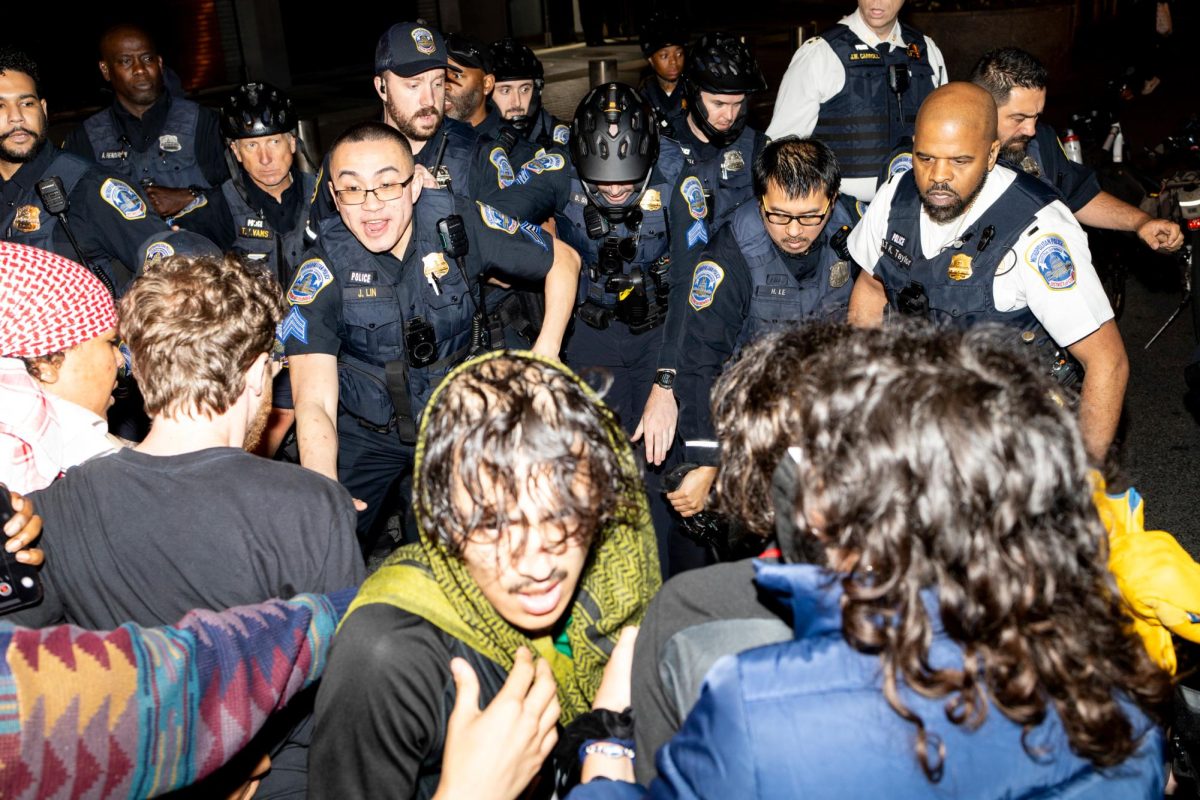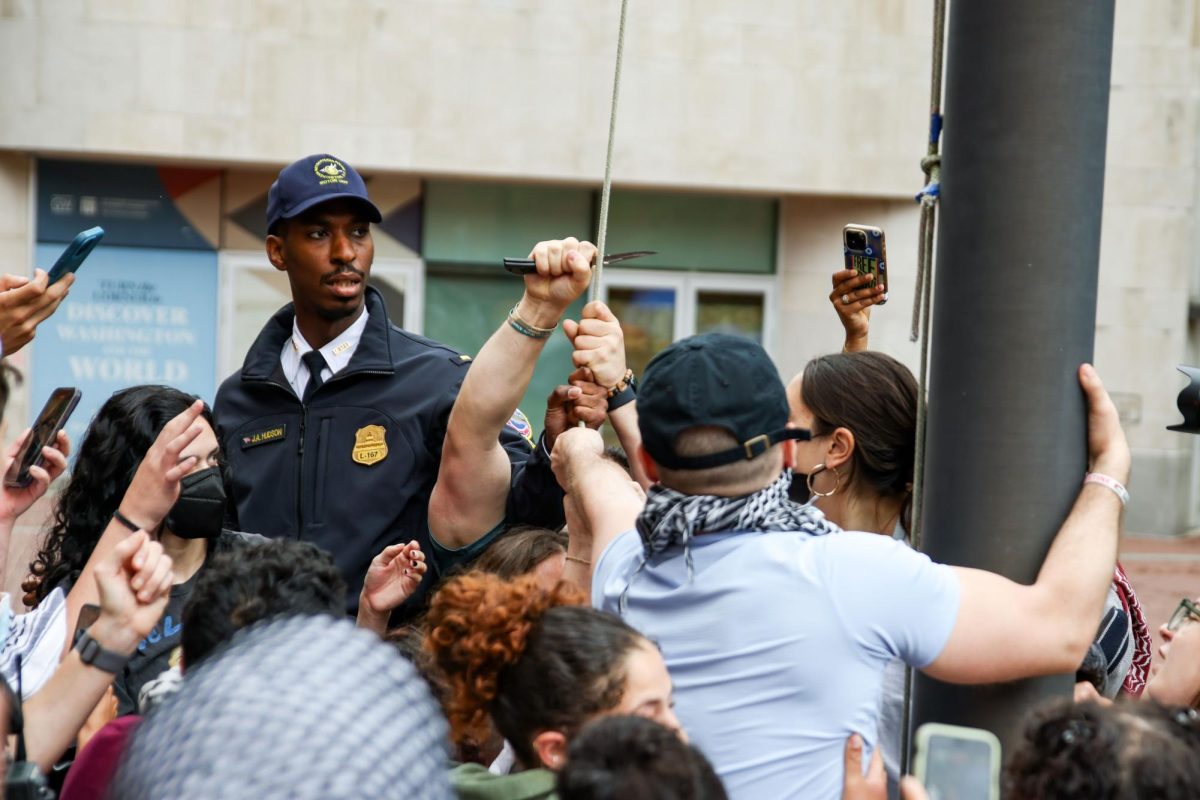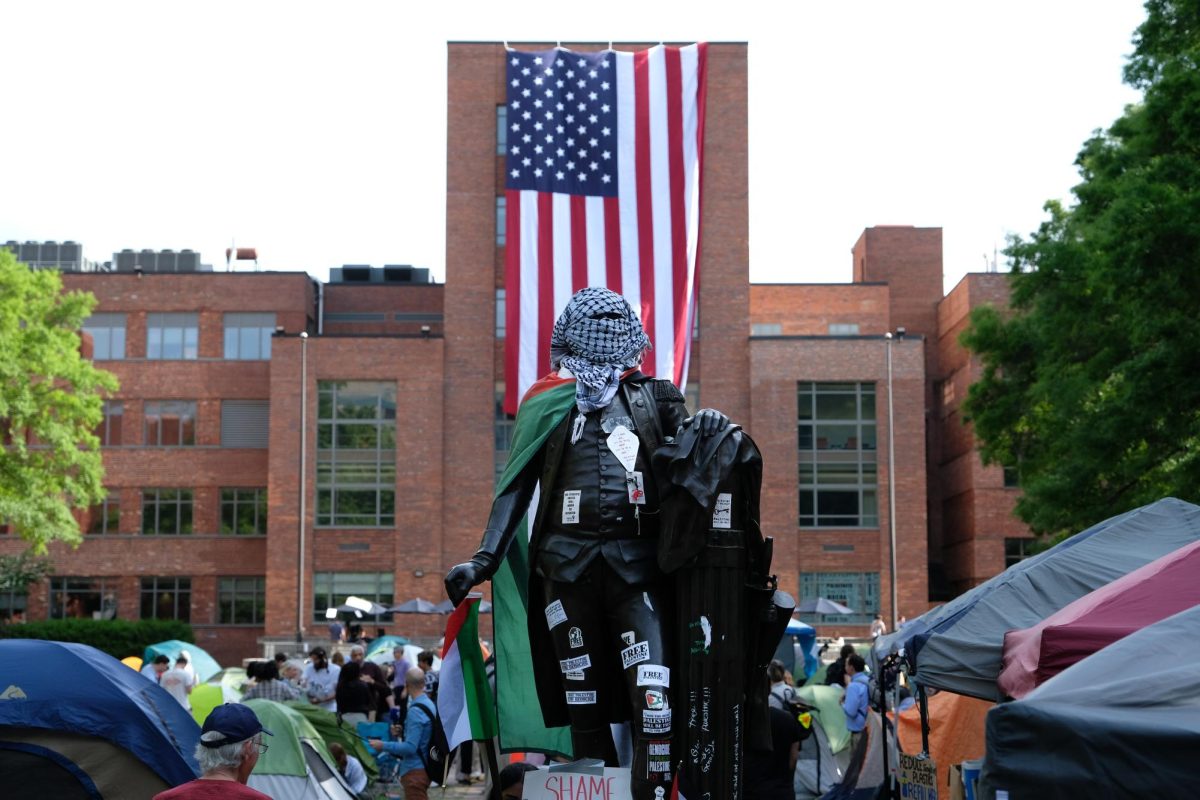Phones pinged in classrooms Wednesday afternoon with alerts of a shelter-in-place order, forcing professors to rely on instinct and each other in the face of unclear instructions from the University.
Officials issued the order via GW Alert at about 4 p.m., about 15 minutes after a man charged with homicide escaped Metropolitan Police Department custody at GW Hospital; police are still seeking 30-year-old Christopher Haynes. Authorities lifted the shelter-in-place order at about 8:15 p.m., but professors said unclear policies and inconsistent enforcement made it hard to decide whether students could actually leave classes or if they should have completely sheltered in place for the entire four-hour advisory.
Even after the initial alert warning of a “dangerous individual” was issued, many students failed to heed the order and left their residence halls and classrooms to walk through campus.
Some faculty said confusion grew about halfway through the shelter-in-place period. Officials issued a 5:54 p.m. alert telling community members to continue to shelter in place but also asking them to exercise caution if they left their shelter. The notification confused professors and students who believed no one was supposed to be outside.
While officials didn’t lift the shelter-in-place order until about 8:15 p.m., several professors said unclear instructions — which led to a lack of clear authority over whether students could stay or leave — caused them to let students leave more than two hours earlier, at 6 p.m.
“The text message was a little confusing,” said Hayley Cutler, an adjunct professor of dance. “I thought that telling us to ‘Shelter in place, but if you choose to leave,’ was a little hard to navigate as a teacher, feeling responsible for the future decisions of the students in that moment.”
GW has emphasized its public safety reforms over the past several years, culminating in the decision to arm officers within the GW Police Department beginning this fall. But confusion stemming from Wednesday’s alerts — like whether students should have stayed put throughout the shelter-in-place order — highlight potential concerns about GW’s emergency communications system.
Cutler said she took her students to the dressing area of the dance studio on G Street when she got the initial shelter-in-place alert and knew what to do “instinctively” but wasn’t “recalling specific protocol” from the University. She said the alert asking community members to use extreme caution if they left shelter was “tricky” for faculty trying to decide whether they should ask students to stay in the room because it implied people could leave before officials issued an all-clear message.
The shelter-in-place entry in GW’s Emergency Response Handbook states that community members must stay in a safe place until the all-clear but does not specify how faculty should manage students wanting to leave the classroom. The guidelines mainly provide advice for dealing with inclement weather, like recommending community members seek shelter in a “low part” of the building without windows and avoid potential falling items.
Cutler said Carl Gudenius, the head of the Theater and Dance Program, contacted her “immediately” to ensure she and her students felt safe in the studio when officials ordered the shelter in place. She said when the community received the alert about using extreme caution if they chose to leave, her class walked out of the building as a group after Gudenius joined them.
“There was a lot of really positive communication from the program head that I felt really good about, so that made me feel comfortable sort of saying ‘Okay, everybody can come out and get your stuff, and then we’ll wait for Carl,'” Cutler said.
University spokesperson Julia Metjian said GW’s Emergency Management team worked with the GW Police Department and MPD to issue the shelter-in-place alert and communicated with GW Hospital, “federal partners” and “other public safety organizations” to assess the situation.
Metjian declined to say whether officials think community members understood expectations for the shelter in place but referred to optional emergency preparedness resources available to faculty.
“In this incident, MPD recommended that the University community shelter in place, which is intended to limit activity outdoors, protect people and allow emergency personnel the ability to do their work,” Metjian said in an email. “We updated the entire GW community frequently as we confirmed additional information and as the emergency and related guidance evolved.”
Thiago da Silva Moreira, a biological sciences faculty member, said his students left his classroom in the Media and Public Affairs building at about 6 p.m. after receiving the 5:54 p.m. alert asking community members to be cautious if they choose to leave, even though officials had not lifted the shelter-in-place order at that time.
“When everybody received those messages, they asked me, ‘Oh, can we leave?’ And I said, ‘I don’t think I can legally hold you in place, so it’s your choice,’” Moreira said.
Moreira said the door to his classroom is “damaged” and opened from the outside without GWorld tap access during the order, even though a GW Alert sent at 4:26 p.m. said officials locked all GWorld readers. He said he still felt “reasonably safe” because the door only opened to the hallway.
Christopher Rollston, the department chair of Classical and Near Eastern Languages and Civilizations, said he was teaching a class in the Smith Hall of Art when officials issued the shelter-in-place order, and the door to the classroom “automatically locked” so anyone entering needed to scan their GWorld card. He said he felt prepared to execute the shelter-in-place protocol because the University asks all CCAS professors to include a safety and security section in their syllabi with links to instructions for “every possible scenario.”
A syllabus template provided by the Office of Academic Planning and Assessment requires that instructors include a reference to the Security and Safety Policy, which includes GWPD’s phone number and links to the Emergency Response Handbook.
“From my perspective, GW prepared faculty well by talking, by saying, ‘Hey, these are things you have to put in your syllabi,'” Rollston said. “That was really useful, if faculty actually read those things they should have been prepared for every scenario.”
Rollston said none of his students left when the class concluded at 5 p.m., with the majority remaining in the room until closer to 6 p.m. when students received the notification about proceeding through campus with caution.
“They were watching out the door between 5 and 6, and they were like, ‘There are a lot of people out there, I think we can go out,’” Rollston said.
Robert Baker, an associate professor of music who was in class with seven students when he received the shelter-in-place notifications, said he walked up and down the halls of the music department in the basement of Phillips Hall to make sure everyone followed the order. But Baker said his students left in groups when officials sent out the alert advising extreme caution but only after he facilitated a conversation about exercising caution and asked his students to text him once they arrived at their residence halls.
Baker added that a rolling metal door slid down to block the entrance to the building’s basement during the order.
“I’m a teacher, this is what we do,” Baker said. “So it felt like enough information do what needed to be done.”
Barbara Benitez-Curry, an assistant professor of media and public affairs, said because she was lecturing, she didn’t know there was a shelter-in-place order until a student told her. Benitez-Curry said she let her students leave the classroom about 25 minutes after officials issued the alert that advised extreme caution after she “checked in” with her SMPA administrator.
“The helicopter was gone, people were walking around everywhere like it was just another day,” Benitez-Curry said. “So when we got that text message, it came just about where my class ended anyway.”
Isabel Matta, a sophomore who was in a Spanish class in Phillips Hall during the incident, said her professor asked students wishing to leave the room before the end of the order to record a video stating their name and taking responsibility for anything that might happen to them after they leave. She said she thought the professor “handled it in the right way,” given that students were asking to leave after receiving the message asking everyone to proceed with caution.
“She basically wanted a video of each kid that left before the shelter-in-place order was lifted saying that, basically, they take responsibility for what happens to them because the professor didn’t want to get in trouble, which I respect a lot,” Matta said.





